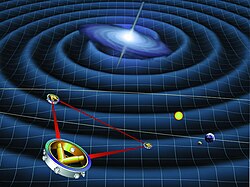
Back تصنيف:برنامج التخطيط لبعثات وكالة الفضاء الأوروبية (2015–2025) Arabic Wissenschaftsprogramm der Europäischen Weltraumorganisation German Programme scientifique de l'Agence spatiale européenne French 欧洲航天局科学计划 Chinese
The Science Programme[1][2][a] of the European Space Agency is a long-term programme of space science and space exploration missions. Managed by the agency's Directorate of Science, The programme funds the development, launch, and operation of missions led by European space agencies and institutions through generational campaigns. Horizon 2000, the programme's first campaign, facilitated the development of eight missions between 1985 and 1995 including four "cornerstone missions" – SOHO and Cluster II, XMM-Newton, Rosetta, and Herschel. Horizon 2000 Plus, the programme's second campaign, facilitated the development of Gaia, LISA Pathfinder, and BepiColombo between 1995 and 2005. The programme's current campaign since 2005, Cosmic Vision, has so far funded the development of ten missions including three flagship missions, JUICE, Athena, and LISA. The programme's upcoming fourth campaign, Voyage 2050, is currently being drafted. Collaboration with agencies and institutions outside of Europe occasionally occur in the Science Programme, including a collaboration with NASA on Cassini–Huygens and the CNSA on SMILE.
- ^ "ESA science programme planning cycles". ESA Science. 4 March 2019. Archived from the original on 7 July 2019. Retrieved 7 July 2019.
The Science Programme of the European Space Agency (ESA) relies on long-term planning of its scientific priorities.
- ^ ESA 2015, "The Science Programme within the Directorate of Science has two main objectives [...] The Science Programme has a long and successful history..."
- ^ ESA Media Relations Office (12 October 2012). "ESA Science Programme's new small satellite will study super-Earths". European Space Agency. Archived from the original on 6 July 2019. Retrieved 6 July 2019.
Studying planets around other stars will be the focus of the new small Science Programme mission, Cheops, ESA announced today. [...] The mission was selected from 26 proposals submitted in response to the Call for Small Missions in March [...] Possible future small missions in the Science Programme should be low cost and rapidly developed, in order to offer greater flexibility in response to new ideas from the scientific community.
- ^ ESA 1995, "ESA's Science Programme has three primary features that single it out among the Agency's activities [...] ESA's Science Programme has consistently focussed on missions with a strong innovative content."
- ^ "Call for a Fast (F) mission opportunity in ESA's Science Programme". ESA Science. 16 July 2018. Archived from the original on 7 July 2019. Retrieved 7 July 2019.
This Call for a Fast mission aims at defining a mission of modest size (wet mass less than 1000 kg) to be launched towards the Earth-Sun L2 Lagrange point as a co-passenger to the ARIEL M mission, or possibly the PLATO M mission.
- ^ ESA 2013, "The ESA scientific programme is based on a continuous flow of projects that fulfil its scientific goals."
- ^ ESF and NRC 1998, page 36, "The fundamental rule of ESRO, and subsequently ESA, has been that ESA exists to serve scientists and that its science policy must be driven by the scientific community, not vice versa [...] [This] explains the determining influence that ESA's advisory structure has on the definition and evolution of the scientific program."
Cite error: There are <ref group=lower-alpha> tags or {{efn}} templates on this page, but the references will not show without a {{reflist|group=lower-alpha}} template or {{notelist}} template (see the help page).
© MMXXIII Rich X Search. We shall prevail. All rights reserved. Rich X Search



